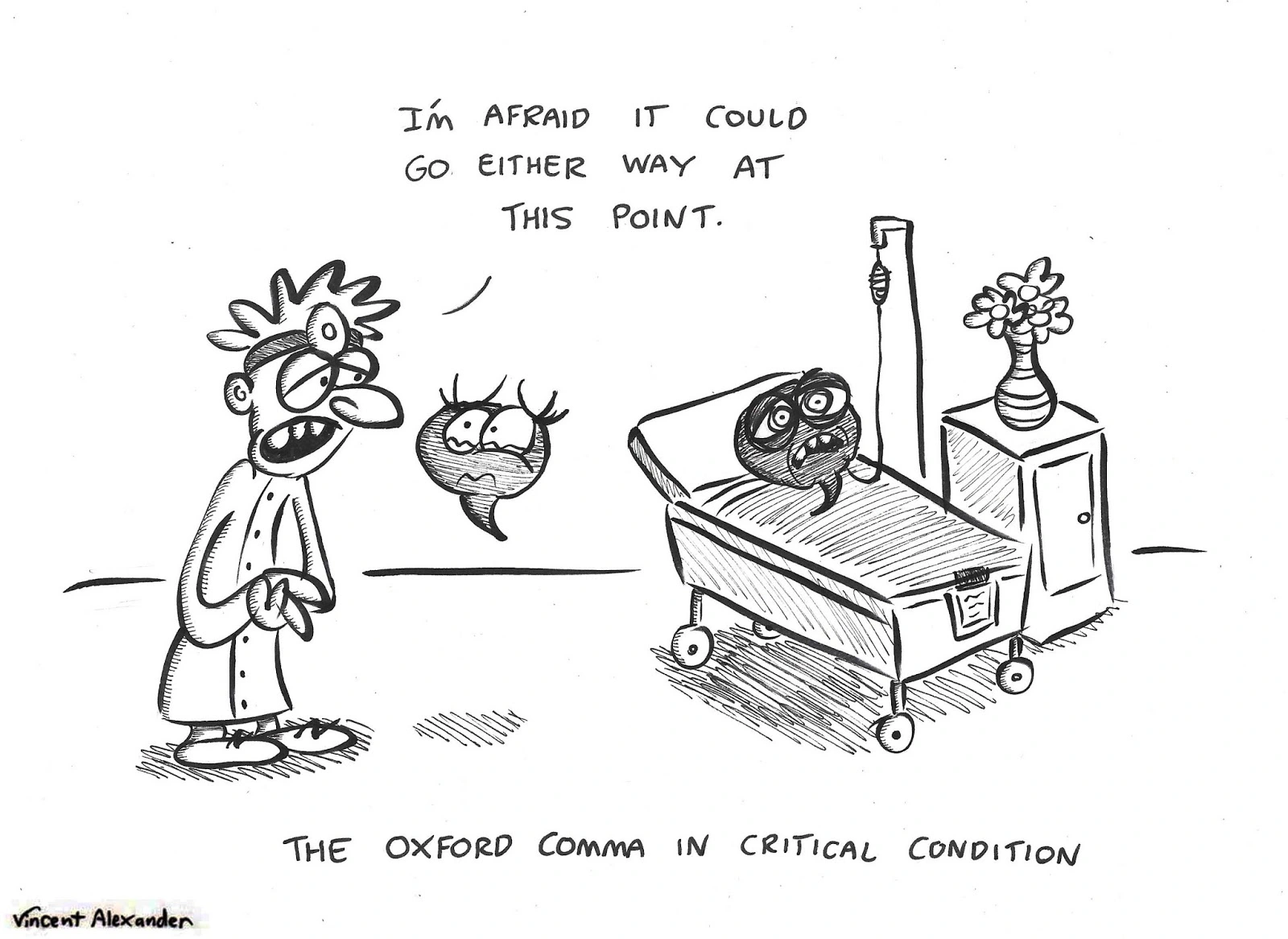
The Oxford comma(no grimacing yet), also known as the serial comma, is a comma used before the final item in a list of three or more items. For example, in the sentence “I love reading, writing, and dancing,” the Oxford comma is the comma after “writing.” Its use has been a topic of debate among writers, editors, and grammarians for years. Time to take a look at the arguments for and against using the Oxford comma, and offer some guidance on when to use it.
The Case for the Oxford Comma
Many writers and editors consider it a crucial element of proper punctuation, while others view it as an unnecessary addition. Despite the debate, there are compelling reasons to use the Oxford comma.
One of the most compelling reasons to use the Oxford comma is clarity. It can help avoid ambiguity and confusion, especially in complex sentences. Consider the following sentence: “We invited the painters, JFK, and Stalin.” Without the Oxford comma, it is unclear whether the sentence refers to inviting two groups of people: painters and JFK, and Stalin, or if the sentence refers to inviting three groups of people: painters, JFK, and Stalin. Adding the Oxford comma clarifies the sentence and eliminates any confusion. It would read, “We invited the painters, JFK, and Stalin.”
Another argument for using the Oxford comma is consistency. When used consistently throughout your writing, it can help create a sense of structure and organization. This can make your writing easier to follow and more polished. Readers will know exactly where one list item ends and the next one begins, which can help them better understand your writing.
Moreover, using the Oxford comma can help you avoid embarrassing mistakes. There are countless examples of sentences that could have been interpreted differently if the it were omitted. One of the most famous examples is a book dedication that reads: “To my parents, Sponge Bob and God.” The absence of the Oxford comma makes it unclear whether the author is thanking their parents, Ayn Rand, and God, or whether they are thanking their parents and dedicating the book to Sponge Bob and God. Needless to say, its can lead to confusion and misinterpretation.
Another reason to use the Oxford comma is to comply with style guides. Many style guides, including the Chicago Manual of Style and the Oxford Style Manual, recommend using the Oxford comma. By following these guidelines, you can ensure that your writing adheres to industry standards and is taken seriously by publishers, editors, and other professionals in your field.
However, not everyone agrees that the Oxford comma is necessary. Some writers and editors argue that it can be redundant and add unnecessary clutter to a sentence. For example, consider the following sentence: “My favorite fruits are apples, bananas, and oranges.” The Oxford comma after “bananas” is unnecessary because it is clear that “oranges” is the final item in the list. In this case, omitting the Oxford comma would not lead to any confusion.
Some argue that its use can vary depending on the context of the sentence. In some cases, it may be necessary to use the Oxford comma for clarity, while in other cases, it may be redundant. It is up to the writer or editor to determine whether the use of the Oxford comma is necessary in each individual case.
The Case Against the Oxford Comma
Here is an example of the quandary around its use in a sentence “I bought apples, bananas, and oranges,” the Oxford comma appears after “bananas.” While many writers and editors use it as a matter of course, there is a growing debate about its usefulness and necessity.
The opponents of the Oxford comma argue that it can be unnecessary and add clutter to a sentence. In some cases, omitting the punctuation mark does not create any confusion or ambiguity. For example, in the sentence “My favorite colors are blue, green and purple,” it is clear that the speaker is referring to three separate colors, and it is unnecessary.
Another argument against the Oxford comma is that it is not always consistent with the style of the writing. Some style guides, such as the AP Stylebook, do not use the Oxford comma, and it can be jarring for readers who are used to that style. In these cases, it may be better to follow the style guide and omit the Oxford comma.
However, even when a style guide omits the Oxford comma, there may be times when using it can improve clarity. For example, in the sentence “I would like to thank my parents, Oprah Winfrey and Nelson Mandela,” the lack of an Oxford comma makes it unclear whether the speaker is thanking three separate entities or whether Oprah Winfrey and Nelson Mandela are the speaker’s parents. Adding an it after “Oprah Winfrey” would clarify that the speaker is thanking three separate entities.
Ultimately, the decision to use or omit the Oxford comma depends on the writer’s personal preference and the context in which the sentence is being used. In some cases, the Oxford comma can improve clarity and avoid ambiguity, while in other cases, it may be unnecessary or inconsistent with the style of the writing.
One way to determine whether the it is needed is to read the sentence aloud and see if there is any confusion or ambiguity. If the sentence reads clearly without, then it may be omitted. However, if there is any possibility of confusion, adding the Oxford comma can help clarify the meaning of the sentence.
In addition, writers should consider the expectations of their audience. If the audience is likely to be familiar with a particular style guide, it may be better to follow that guide’s rules. On the other hand, if the audience is more general, using the it may be a safer choice to ensure clarity and avoid confusion.
When to Use the Oxford Comma
It is placed before the conjunction (usually “and” or “or”) that precedes the final item in the list. Its use has been a subject of debate among writers and editors for many years.
Many proponents of the Oxford comma argue that its use can enhance clarity and consistency in certain situations. In academic writing, where precision and clarity are essential, its use can help to avoid confusion and ensure that the intended meaning is conveyed accurately. The same is true in technical writing, where precision and clarity are also paramount.
In legal writing, the use of the Oxford comma can be particularly important, as the absence of a comma can sometimes lead to ambiguity and misinterpretation. For example, consider the following sentence: “This contract excludes liability for damage to the property of the tenant, the landlord and the managing agent.” Without a comma, it is unclear whether the managing agent is included in the exclusion of liability or not. With an Oxford comma, the sentence would read: “This contract excludes liability for damage to the property of the tenant, the landlord, and the managing agent.” This makes it clear that the managing agent is indeed included in the exclusion of liability.
When listing items that contain commas, the use of the Oxford comma can also be helpful in avoiding confusion. For example, consider the following sentence: “I would like to thank my parents, Oprah Winfrey and God.” Without a comma, it may appear that the speaker’s parents are Oprah Winfrey and God. With an Oxford comma, the sentence would read: “I would like to thank my parents, Oprah Winfrey, and God.” This makes it clear that the speaker’s parents are not Oprah Winfrey and God, but rather separate entities.
Ultimately, whether to use the Oxford comma is a matter of personal preference and style. However, there are some situations where it is generally recommended to use it. These include:
- In academic writing, where clarity and consistency are important.
- In technical writing, where precision and clarity are essential.
- In legal writing, where the absence of an Oxford comma can sometimes lead to ambiguity and misinterpretation.
- When listing items that contain commas, to avoid confusion. For example, “My favorite movies are The Godfather, Goodfellas, and The Shawshank Redemption.”
The Oxford comma has been the subject of much debate among writers and editors. While there are arguments for and against its use, ultimately it is up to the writer to decide whether or not to use it.


